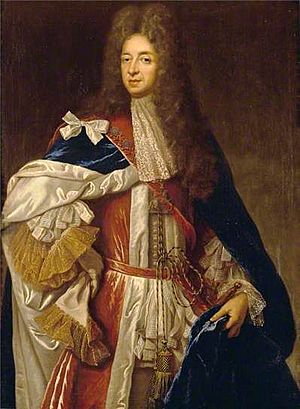William Herbert, 1st Marquess of Powis facts for kids
Quick facts for kids
The Most Honourable
The Marquess of Powis
|
|
|---|---|
| Marquess of Powis | |

Portrait of Lord Powis, attributed to François de Troy
|
|
| Lord Lieutenant of Cheshire | |
| Reign | 1688 - 1688 |
| Predecessor | The Earl of Derby |
| Successor | The Earl of Derby |
| Born | William Herbert 1626 |
| Died | 2 June 1696 (aged 69–70) St Germain |
| Spouse(s) | |
| Issue | Frances Mackenzie, Countess of Seaforth William Herbert, 2nd Marquess of Powis Lady Mary Maxwell Anne Smith, Viscountess Carrington Winifred Maxwell, Countess of Nithsdale |
| Parents | Percy Herbert, 2nd Baron Powis Elizabeth Craven |
William Herbert, 1st Marquess of Powis (1626 – 2 June 1696) was an important English nobleman. He is mostly remembered for the difficulties he faced during a time called the Popish Plot.
William Herbert became the 3rd Baron Powis in 1667 after his father passed away. Later, King Charles II made him the Earl of Powis in 1674. King James II then gave him even higher titles in 1687, making him Viscount Montgomery and Marquess of Powis. He also became a member of the King's special advisory group, the Privy Council, in 1686.
Contents
Early Life and Family
William Herbert was the only son of Percy Herbert, 2nd Baron Powis and Elizabeth Craven. His only sister, Mary Herbert, married George Talbot.
His mother, Elizabeth Craven, was the oldest daughter of Sir William Craven, who was a Lord Mayor of London.
Facing Challenges and Loyalty
William Herbert and his wife were leaders of the Roman Catholic community in England. This was a difficult time for Catholics.
The Popish Plot
William Herbert was one of "Five Catholic Lords" who were falsely accused during the Popish Plot. This plot was a made-up story by a man named Titus Oates, who claimed there was a plan to kill the King. Because of these false accusations, William Herbert was held in the Tower of London for six years.
His wife, Lady Elizabeth, worked very hard to try and free him. She even created a false story herself, which almost got her into serious trouble. Luckily, William Herbert was finally set free in 1684.
Loyalty to King James
After the Glorious Revolution in 1688, King James II was removed from the throne. William Herbert remained loyal to him. He helped King James's wife, Queen Mary, and their baby son, James, Prince of Wales, escape to France.
As a reward for his loyalty, King James gave him new titles in France, making him "Duke of Powis" and "Marquess of Montgomery" in what was known as the Jacobite Peerage. These titles were recognized by King James but not by the new English government.
Life in Exile
In 1690, William Herbert went to Ireland with King James. He became one of King James's main advisors and was made Lord Chamberlain. He stayed in Ireland until King James had to return to France after the Battle of the Boyne.
William Herbert then settled at King James's court in exile at St Germain, France. He was an important person there, serving as Lord Steward and Lord Chamberlain of the royal household. His wife continued to serve Queen Mary of Modena and was the royal governess to Prince James until her death in 1691.
King James made William Herbert a Knight of the Garter in 1692. Even though he held important positions, he struggled to manage the royal household because they had very little money. He had lost many of his family's lands and wealth in England, showing how much he gave up for King James.
Personal Life
In July 1654, William Herbert married Lady Elizabeth Somerset. She was a daughter of Edward Somerset, 2nd Marquess of Worcester. They had six children together: one son and five daughters.
One of their daughters, Winifred, married William Maxwell, 5th Earl of Nithsdale. He was sentenced to death for his part in the Jacobite rising of 1715. Lady Nithsdale became famous for bravely helping her husband escape from the Tower of London. Another daughter, Lady Lucy Herbert, became a nun and a writer of religious books.
William Herbert died on 2 June 1696, at about 70 years old, after a riding accident in St Germain. He was buried there the next day.
His only son, William Herbert, became the 2nd Marquess of Powis. He also faced challenges and was jailed in the Tower of London for being a Jacobite. He fought a long legal battle to get some of his family's property back. In 1722, the titles and lands that his father had lost were given back to him.
Images for kids


